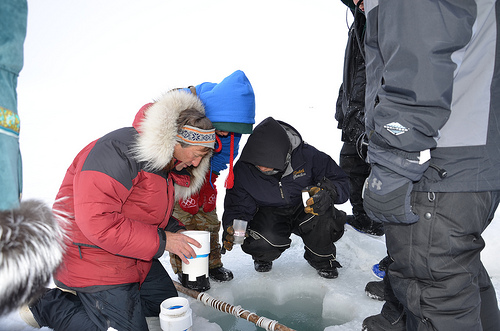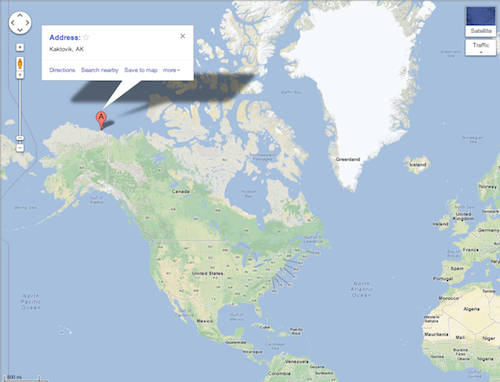 Marine science professor Ken Dunton takes water samples with high school students from Kaktovik, Alaska. Through the Student Sampling Program, which Dunton recently created, students interns are paid to collect samples throughout the year. Their dataset will be the first of its kind.
Marine science professor Ken Dunton takes water samples with high school students from Kaktovik, Alaska. Through the Student Sampling Program, which Dunton recently created, students interns are paid to collect samples throughout the year. Their dataset will be the first of its kind.
The Summer Science Program in Kaktovik, Alaska, is in many respects your typical one-week marine biology camp. The kids learn about aquatic and coastal ecosystems. They go out on the water, collect samples, bring them back to the classroom, look at them through microscopes, and classify them. They do art projects, go to the beach, hang out, and finish up the week with an open house where they show off what they’ve done to their parents.
Then there are the ways in which it’s not such a typical camp. The kids dissect small sharks and analyze seal blubber. They’re on the water in a hardcore scientific research vessel. They receive on-site lessons from Ken Dunton and Jim McClelland, two of the world’s leading experts on the marine ecosystems of the arctic. Their teachers come from Port Aransas, Texas, about 5,000 miles away. There are polar bears tromping around in the background. And when they learn about food webs, the kids, who are Iñupiat Eskimo, have a perspective on them that’s rare.
“They recognize, in a way most of us don’t, that they’re part of the foodweb,” said Dunton, professor of marine science in the College of Natural Sciences. “Seals eat fish. The polar bears eat the seals, and sometimes they eat the polar bears. They live it every day. It’s a reality for them.”
That blend, of the normal and the extreme, is characteristic of life in the City of Kaktovik, population 239, which sits on the northeast tip of Barter Island, at the very top of Alaska, deep inside the Arctic National Wildlife Refuge (ANWR), hundreds of miles away from its closest neighbor.
 The City of Kaktovik, population 239, sits on the northeast tip of Barter Island, at the very top of Alaska, deep inside the Arctic National Wildlife Refuge (ANWR), hundreds of miles away from its closest neighbor.“It’s very remote,” said Dunton. “You’ve got the oil field at Prudhoe Bay about 170 kilometers to the west and Herschel Island 100 km to the east in Canada, but Herschel is only occupied in summer. When the high school basketball team wants to play a game, they must hop on a small twin engine prop plane and fly quite a distance.”
The City of Kaktovik, population 239, sits on the northeast tip of Barter Island, at the very top of Alaska, deep inside the Arctic National Wildlife Refuge (ANWR), hundreds of miles away from its closest neighbor.“It’s very remote,” said Dunton. “You’ve got the oil field at Prudhoe Bay about 170 kilometers to the west and Herschel Island 100 km to the east in Canada, but Herschel is only occupied in summer. When the high school basketball team wants to play a game, they must hop on a small twin engine prop plane and fly quite a distance.”
Dunton, who has been going to Kaktovik since 1977 in order to study the coastal ecosystems of the Chukchi and Beaufort seas and to better understand their resilience to potential threats like climate change and industrial development, started the camp for a few reasons. One was to give back to the community that had hosted him so generously for so long. Another was because he realized how profoundly his research intersects with the future of the Iñupiat, who depend on the local ecosystems for survival.
“It’s a modern place,” said Dunton. “They have TV, the Internet, cell phones, video games. But they also have to fish and hunt to feed themselves. Over 90% of the residents of Kaktovik practice a subsistence lifestyle. They must—hunting and fishing provide their main source of food, especially for the long winter period.”
Not just the Iñupiat diet but Iñupiat culture depends on what choices are made, in particular, about drilling. There are vast reserves of oil underneath both the land in ANWR and the waters off the coast. To this point there’s been no drilling, and very limited exploration in the eastern Alaska Beaufort Sea. That could change very quickly, however, depending on the politics.
The issues of oil development quietly fill the air in Kaktovik. The oil companies regularly send representatives to town to talk to local citizens. They share their concerns regarding drilling and the precautions they will take to minimize ecological disturbance and the benefits they can provide to the community. Environmental groups come and try to persuade the Iñupiat to oppose drilling not just off the coast, which is what threatens their lifestyle most directly, but inland as well, where the ecological threat is more acute for other native groups, who depend heavily on the caribou herds for subsistence.
On top of all that are the politicians, who are trying to negotiate the competing economic, environmental and social interests that swirl around ANWR.
“Just in the few weeks we were there this past August, there were visits from U.S. Senator Murkowski, the head of U.S. Fish and Wildlife, and a top-ranking official from the National Oceanic and Atmospheric Administration,” said Susan Linn, a graduate student of Dunton and his director of outreach in Kaktovik.
The biggest issue for the Iñupiat is what impact drilling offshore would have on their annual bowhead whale hunt, a centuries-old tradition that they have a special exemption from whaling bans to pursue. They can take up to three whales a year.
The Summer Science Program doesn’t address these big issues. In some respects it’s a break from them. But the science that the kids are studying is precisely what they’ll need to know in order to make informed decisions about how to deal with drilling and exploration issues. And that underlying significance may be part of what drives the intense interest they’ve shown in the camp.
“When we first started,” said Linn, “we had planned on starting it at ten in the morning. We’d been warned that everyone stays up late, because in the summer the sun is shining 24 hours a day, and in fact we worried that even ten would be too early. Once we started, though, the kids demanded more time. So we did 8-6, which is a long day.”
Encouraged by this enthusiasm, Dunton began to employ students to help with his research. He recruited six high school students in Kaktovik, and he and McClelland trained them in how to use their scientific instruments, collect small invertebrate animals in traps, and maintain a field notebook. The students work on the ice weekly from April to June, accompanied by a town elder, collecting data and placing water and biological samples in a freezer
The goal is to teach them about scientific research. It’s also to give Dunton and his colleagues access to ecological data they simply can’t acquire themselves, because they’re not there throughout the year. And it’s an extension, he says, of the collaborative nature of all of his interactions with the Iñupiat.
“There is a lot going on during the winter,” he said. “We are just beginning to see how the processes that occur under the ice are responsible for the surprising productivity of the lagoons. But traditional native knowledge is also helping us understand how the system functions, and especially provides us with a perspective on broad spatial and temporal scales that we simply can’t get over a two year study period. It’s a two-way learning process, and we are learning from each other. It is quite exciting and rewarding. The locals possess a basic and fundamental knowledge of the ecosystem—we just need to take the time to patiently listen.”

















Comments 1
Do you still do this camp? Do you have applications for teachers to act as counselors? I will be teaching in St. Paul, AK and would love to go to this village. I have been to Point Hope on the western side of AK and am a little familiar with this area.